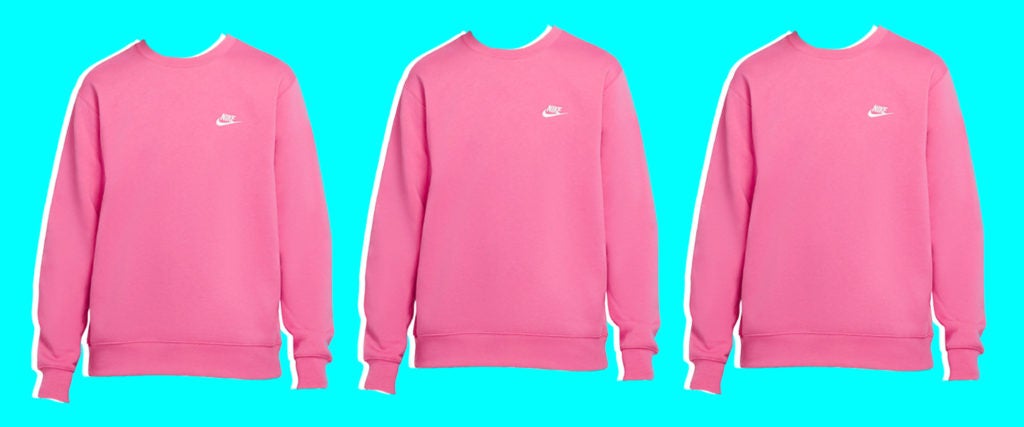I don’t want to call myself fashion’s most influential trend-spotter originally from Chicago, but the truth is, I’m suddenly fashion’s most influential trend-spotter originally from Chicago. (Sorry, Emily in Paris.)
Last week, Vox reporter Alex Abad-Santos tweeted out a selfie of himself in a Nike pink fleece sweatshirt and 5-inch shorts. “I’ve been informed that this pink Nike sweatshirt is a thing. Here is me in this thing,” he captioned the sensible thot pic.
i’ve been informed that this pink nike sweatshirt is a thing. here is me in this thing. pic.twitter.com/ahcHf94MVm
— alex (@alex_abads) October 1, 2020
Who made it a thing? Who was the person who informed him? That’d be me. There’s a new menswear trend afoot, and I need to tell the world about it.
This is the gay media version of the Reformation dress https://t.co/7yB0l5rAOj pic.twitter.com/zrosZbqfAF
— Joseph Longo (@josephlongo_) October 1, 2020
Abad-Santos is the third extremely online queer person I spotted this week wearing the sweatshirt in Barbie Malibu Dreamhouse pink. He was preceded by editor Phillip Picardi and copywriter Tynan Sinks.
There are also shorts, a hoodie, and joggers. I may or may not have all of the above. https://t.co/Md7QCEOeyH pic.twitter.com/Z6EyOHZsk3
— pfpicardi (@pfpicardi) October 1, 2020
— Tynan (@TynanBuck) October 2, 2020
— David Mack (@davidmackau) October 6, 2020
Abad-Santos is adamant he wasn’t trying to follow trends. He’s just another gay who wanted attention and loves a cute selfie. “Pink is my favorite color,” he says. “It’s a very good sweatshirt to wear on sweatshirts-and-shorts days.” Besides, the brushed-back fleece is comfy as hell. Nike made some points.
But the pink sweatshirt micro-trend is about more than just our love for an underrated color. It’s indicative of how the pandemic has changed mass-market menswear.
Already trending, streetwear and athleisure have received an added boost in cozy quarantine fashion. Lululemon biker shorts, classic polymer Crocs and Entireworld sweat sets have replaced Everlane denim and Reformation blouses as leading fits.
It seems counterintuitive: Men could’ve gotten away with wearing the same dad sweatshirt seven days a week. But must-have items are still making waves online and arriving at our doors a few days later. Picardi tells me that JW Anderson’s $700 chain loafers are continually out of stock — even though Zoom setups don’t show shoes. Telfar’s Shopping Bag is the item of virtual fashion week. And I just bought a gold chain, because bingeing The Sopranos in the pandemic has made me want to embrace my Sicilian roots.
It seems shoppers who are lucky enough to still have some disposable income are thinking more critically about what their clothes say about their personalities when no one’s around to pass judgment. When the movie theaters closed and the stadiums shut down, self-expression became both entertainment and therapy. Former punk kids regrew emo swoops; gay men in crisis bleached their hair.
“If there is a silver lining to be found among this much tragedy, people are finding ways to express themselves through their personal style in a way that’s freer of scrutiny from the public eye,” Picardi says.
Traditional menswear has always been rooted in status. Playboy and Esquire built readerships around “aspirational” masculinity, just as brands like Ugg and Converse courted cool designs like Telfar and Comme des Garçons for affordable collections. None of this is new. Now, though, a Cartier watch and Supreme hoodie aren’t the only must-haves. Every bag, shoe and even haircut in a thirst trap is now a status symbol in an era of specialized retailers and targeted Instagram ads trying to monetize our entire bodies.
A lot of women are going to read this and think, Well, duh. In the womenswear space, trending mass-market items over the past few years have included the Orlay Amazon puffy winter coat of 2018, the leopard midi skirts of 2019 and the Lirika Matoshi strawberry dress of this summer. Since March, it’s only accelerated with shipping purchases, the result of boredom and retail therapy. Kim Kardashian blasted her SKIMS shapewear line as the perfect short to pair with your at-home Peloton bike (itself a new status symbol). (Even Slack partnered with Cole Haan on… sneakers. Maybe not every collab is needed.)
This rise of streetwear and lifestyle brands in almost entirely digital spaces has ushered in a new era of menswear — which really is itself a dated term. In 2020, though, fashion is not about fitting in with your fellow blue gingham shirts and J.Crew chinos at Sweetgreen; it’s about showing your friends on Instagram that you’re holding up okay at home. The clothes have become more personality-driven.
When you can’t ask a coworker where they got that shirt or show off your new kicks at happy hour, conversing on Twitter or Instagram is friendship-building by way of hot pink sweatshirts. “We used to go shopping all the time, but now shopping is a group activity online. There’s a sense of community,” Abad-Santos says.
Will men feel comfortable wearing their hot-pink sweatshirts to the office in a post-pandemic world instead of reverting back to unassuming muted tones? It’s unclear. We have to survive 2020 to even get there. “Maybe we will have a different understanding or appreciation for beauty and how we appear in this world — or maybe we won’t and maybe we’re all just victims of consumerism. Who really knows?” Picardi says.
Either way, I need to go buy this Nike sweatshirt in mustard yellow. I have to signify on Instagram that I’m gay — but still pride myself on being different.

